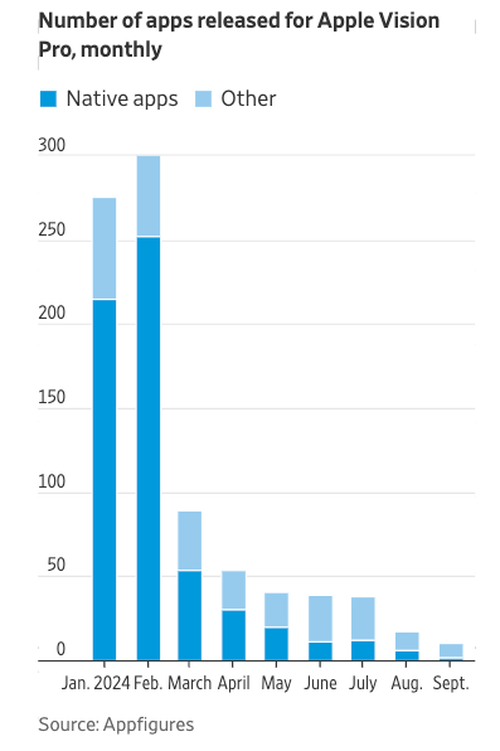The number of new apps released for Apple Vision Pro has slid since the mixed-reality headset became available for purchase on February 2. Without killer apps, the success of the over-priced goggles will flounder.
Wall Street Journal reports that the Vision Pro app ecosystem has experienced a significant slowdown in growth since the launch. Demand for the base $3,499 Vision Pro has been out of reach for many consumers struggling to survive in an era of elevated inflation and high interest rates. The glasses were likely mispriced, hence sluggish demand.
More from WSJ:
There has been a significant slowdown in new apps coming to the Vision Pro every month. Only 10 apps were introduced to the Vision App Store in September, down from the hundreds released in the first two months of the device's launch, according to analytics firm Appfigures.
It has counted around 1,770 apps available for the Vision Pro in the App Store as of September. Only 34% of those apps are built specifically for the Vision Pro, while the rest are versions of existing Apple apps that have additional Vision Pro functionality, Appfigures said.
Apple said in August that there are more than 2,500 apps built for the Vision Pro. Appfigures said the discrepancy between these two figures could be, in part, because some apps aren't used enough to register on usage charts, making them difficult for the analytics firm to detect.
A visualization from the Journal shows a large decline in the number of new apps released for Vision Pro every month since its launch.

App growth for Vision Pro has fallen off a cliff, and that's mostly because demand for the futuristic ski goggles costs too damn much for the consumer. It's literally worth a couple of months of rent or three months of car payments for many average consumers.
Audible groans when the price for Apple's Vision Pro is announced.
— Citizen Free Press (@CitizenFreePres) June 6, 2023
$3500 to disconnect from reality. No thanks. pic.twitter.com/nFLSlCtWZ7
Even though Apple hasn't officially released Vision Pro sales figures, TF International Securities analyst Ming-Chi Kuo (best known for gathering intelligence from his contacts in Apple's Asian supply chain) wrote in a note in late April that shipments for the goggles will be around 400k and 450k units for the year, down from earlier estimates of 700k and 800k.
Separately, Counterpoint Research wrote in a report that Vision Pro's second-quarter sales figures imploded 80% from the first quarter.
"To catch on, the Vision Pro would need killer apps, which helped turn the iPhone into one of the most popular consumer products in history," WSJ noted.
However, as we previously noted...
Vision Pro's Success Hinges On Cheaper Version As Consumers Balk At $3,500 Price Tag https://t.co/DlTGIIKHNB
— zerohedge (@zerohedge) July 11, 2024
Just like the AI-enabled iPhone 16, another bust for Apple.
Yet, Apple's market capitalization is somehow at $3.5 trillion.
Moar buybacks, Tim Cook.
The number of new apps released for Apple Vision Pro has slid since the mixed-reality headset became available for purchase on February 2. Without killer apps, the success of the over-priced goggles will flounder.
Wall Street Journal reports that the Vision Pro app ecosystem has experienced a significant slowdown in growth since the launch. Demand for the base $3,499 Vision Pro has been out of reach for many consumers struggling to survive in an era of elevated inflation and high interest rates. The glasses were likely mispriced, hence sluggish demand.
More from WSJ:
There has been a significant slowdown in new apps coming to the Vision Pro every month. Only 10 apps were introduced to the Vision App Store in September, down from the hundreds released in the first two months of the device's launch, according to analytics firm Appfigures.
It has counted around 1,770 apps available for the Vision Pro in the App Store as of September. Only 34% of those apps are built specifically for the Vision Pro, while the rest are versions of existing Apple apps that have additional Vision Pro functionality, Appfigures said.
Apple said in August that there are more than 2,500 apps built for the Vision Pro. Appfigures said the discrepancy between these two figures could be, in part, because some apps aren't used enough to register on usage charts, making them difficult for the analytics firm to detect.
A visualization from the Journal shows a large decline in the number of new apps released for Vision Pro every month since its launch.

App growth for Vision Pro has fallen off a cliff, and that's mostly because demand for the futuristic ski goggles costs too damn much for the consumer. It's literally worth a couple of months of rent or three months of car payments for many average consumers.
Audible groans when the price for Apple's Vision Pro is announced.
— Citizen Free Press (@CitizenFreePres) June 6, 2023
$3500 to disconnect from reality. No thanks. pic.twitter.com/nFLSlCtWZ7
Even though Apple hasn't officially released Vision Pro sales figures, TF International Securities analyst Ming-Chi Kuo (best known for gathering intelligence from his contacts in Apple's Asian supply chain) wrote in a note in late April that shipments for the goggles will be around 400k and 450k units for the year, down from earlier estimates of 700k and 800k.
Separately, Counterpoint Research wrote in a report that Vision Pro's second-quarter sales figures imploded 80% from the first quarter.
"To catch on, the Vision Pro would need killer apps, which helped turn the iPhone into one of the most popular consumer products in history," WSJ noted.
However, as we previously noted...
Vision Pro's Success Hinges On Cheaper Version As Consumers Balk At $3,500 Price Tag https://t.co/DlTGIIKHNB
— zerohedge (@zerohedge) July 11, 2024
Just like the AI-enabled iPhone 16, another bust for Apple.
Yet, Apple's market capitalization is somehow at $3.5 trillion.
Moar buybacks, Tim Cook.


